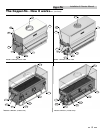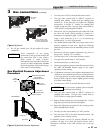
2 Venting (continued)
15
Installation & Service Manual
Locate appliance as close as possible to a chimney or gas vent.
Avoid long horizontal runs of the vent pipe, 90° el bows,
reductions and restrictions. Horizontal por tions of the
venting system shall be supported to prevent sagging.
Horizontal runs must slope up wards not less than 1/4 inch
per foot (21 mm/m) from the appliance to the vent terminal.
Follow manufacturer’s instructions.
Do not use an existing chimney as a raceway for a flue pipe if
another appliance or fireplace is vented through the chimney.
The weight of the venting system must not rest on the
appliance. Adequate support of the venting sys tem must be
provided in compliance with local codes and other applicable
codes. All connections should be secured with rustproof
sheet metal screws.
Vent connectors serving appliances vented by nat u ral draft
shall not be connected to any portion of a
me chan i cal draft system operating under positive
pres sure. Connection to a positive pressure chim ney may
cause flue products to be discharged into the living space
causing serious health injury.
Common venting systems may be too large when an existing
appliance is removed. At the time of removal of an existing
appliance, the following steps shall be followed with each
appliance remaining connected to the common venting
system placed in operation, while other appliances remaining
con nect ed to the common venting system are not in
operation.
(a) Seal any unused opening in the common venting
system.
(b) Visually inspect the venting system for proper size
and horizontal pitch and determine there is no
blockage or restriction, leakage, corrosion and other
deficiencies which could cause an unsafe condition.
(c) Insofar as is practical, close all building doors and
windows and all doors between the space in which
the appliances remaining connected to the common
venting system are located and other spaces of the
building. Turn on clothes dryers and any other
appliances not connected to the common venting
system. Turn on any exhaust fans, such as range
hoods and bathroom exhausts, so they will operate
at maximum speed. Do not operate a summer
ex haust fan. Close fireplace dampers.
(d) Place in operation the appliance being inspected.
Follow the lighting instructions. Adjust thermostat
so appliance will operate continuously.
(e) Test for spillage at the draft hood/relief opening after 5
minutes of main burner operation. Use the flame of a
match or candle, or smoke from a cigarette, cigar or
pipe.
(f) After it has been determined that each appliance
remaining connected to the common venting system
properly vents when tested as outlined above, return
doors, windows, exhaust fans, fireplace dampers and
other gas burning ap pli anc es to their previous
conditions of use.
(g) Any improper operation of the common venting
system should be corrected so that the installation
conforms to the latest edition of the Na tion al Fuel Gas
Code, ANSI Z223.1. In Canada, the latest edition of
CGA Standard B149 Installation Code for Gas Burning
Appliances and Equipment. When resizing any
por tion of the common venting system, the common
venting system should be resized to ap proach the
min i mum size as determined using the appropriate
tables in Part 11 in the latest edition of the National
Fuel Gas Code, ANSI Z223.1. In Canada, the latest
edition of CGA Stan dard B149 Installation Code for
Gas Burning Appliances and Equipment.


















